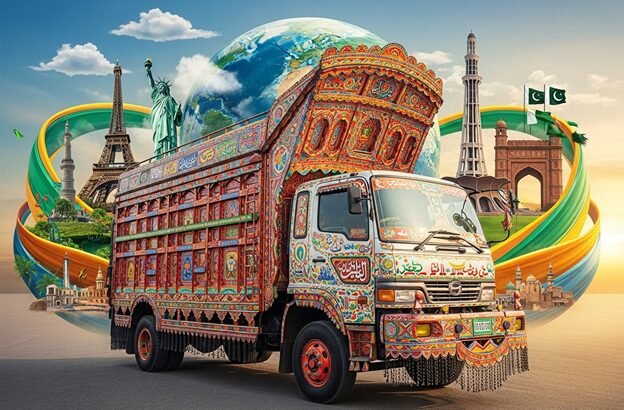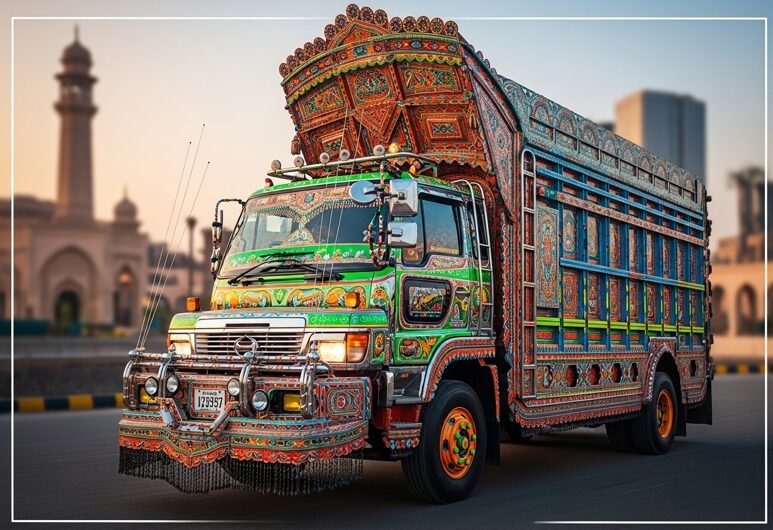Pakistani truck art is one of the most striking cultural symbols of South Asia. With its vivid colors, floral motifs, calligraphy, and storytelling designs, this traditional art form has transcended the highways of Pakistan and found a place on the global stage. Once viewed only as decoration for transport vehicles, truck art has now become a celebrated medium of cultural identity, innovation, and soft diplomacy.
Origins of Truck Art in Pakistan
The tradition of truck art began in the mid-20th century when truck owners sought to personalize their vehicles. Skilled artisans decorated the trucks with bright paint, intricate designs, and religious or poetic verses. Over time, these moving canvases evolved into a unique expression of Pakistan’s cultural diversity, often showcasing images of landscapes, folklore, animals, and national heroes.
Truck art also carried symbolic value: many drivers believed that vibrant paintings, eyes on bumpers, or protective calligraphy would bring good luck and safety during long journeys.
From Highways to Global Galleries
Today, Pakistani truck art is no longer confined to highways. It has been showcased in art galleries across Europe, North America, and the Middle East. Prestigious museums, cultural institutions, and international festivals have featured exhibitions dedicated to this form of folk art, elevating it from street culture to global recognition.
In countries like the United States and the United Kingdom, artists and curators have introduced truck art as a representation of Pakistan’s creativity, resilience, and colorful traditions.
Truck Art in Fashion and Lifestyle
The global revival of truck art has extended its influence into fashion and lifestyle industries. Designers have incorporated truck art motifs into clothing lines, handbags, and shoes, while interior décor brands have created furniture, crockery, and accessories inspired by its vibrant patterns.
Collaborations between Pakistani artisans and international fashion houses have not only revived this art form but also generated economic opportunities for local craftsmen. These partnerships allow artisans to share their skills with a global audience while ensuring financial sustainability.

Cultural Diplomacy and Soft Power
Truck art is also playing an essential role in cultural diplomacy. Pakistan’s government and private institutions have organized cultural exchanges where truck art is used to represent the country’s heritage. For instance, entire buses and vehicles in cities like London, Melbourne, and Washington, D.C., have been painted with truck art to showcase Pakistan’s identity abroad.
Such initiatives enhance Pakistan’s soft power by promoting cultural understanding and reshaping global perceptions of the country.
Preserving a Living Tradition
While truck art thrives internationally, efforts are being made to preserve its roots. Training workshops, vocational programs, and cultural initiatives are equipping the younger generation of artisans with the skills to continue this tradition. By merging authenticity with innovation, truck art is not only preserved but also adapted to modern trends.
This revival ensures that Pakistani truck art remains a bridge between heritage and modernity, inspiring both locals and international admirers.
Conclusion
The global revival of Pakistani truck art reflects its universal appeal. From highways to international galleries, from household décor to high-end fashion, this vibrant art form has traveled far beyond its origin. It stands as a testament to Pakistan’s rich culture, creativity, and resilience.
As the world embraces truck art, it becomes more than just decoration—it becomes a symbol of pride, identity, and cultural diplomacy for Pakistan on the global stage.




